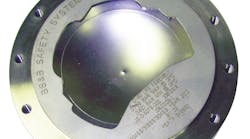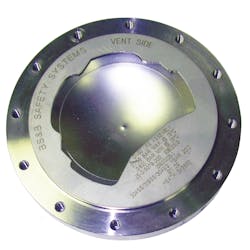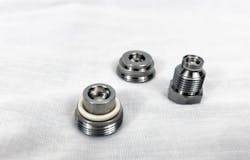Integrated Rupture Disk Assemblies for OEM Hydraulic & Pneumatic Equipment
For more than 85 years, rupture disks have served as an effective passive safety mechanism to protect against overpressure or potentially damaging vacuum conditions. The disk, which is a one-time-use membrane made of various metals including exotic alloys, is designed to activate within milliseconds when a pre-determined differential pressure is achieved.
Equipment reliability in operation is essential for its owner, and this demands high integrity from the pressure relief technology used to protect low and high-pressure OEM systems. As a result, OEMs are increasingly turning to integrated rupture disk assemblies with all components combined by the manufacturer, as opposed to loose rupture disk and holder devices that leave much to chance. These assemblies are being tailored to the application, miniaturized, and use a wide range of standard and exotic materials, as required. This approach ensures the rupture disk device performs as expected, enhancing equipment safety, reliability, and longevity while simplifying installation and replacement.
Separate Components Versus Integrated Assemblies
Traditionally, rupture disks began as standalone components that are combined with the manufacturer's separate holder device at the point of use. The installation actions of the user contribute significantly to the function of the rupture disk device. When installed improperly, the rupture disk may not burst at the expected set pressure. There is a delicate balance between the rupture disk membrane, its supporting holder, and the flanged, threaded or other fastening arrangement used to locate the safety device on the protected equipment.
For this reason, an integrated rupture disk assembly is often a better choice than separable parts. Available ready-to-use and with no assembly required, integrated units are certified as a device to perform at the desired set pressure. The one-piece design allows for easier installation and quick removal if the rupture disk is activated.
The assembly includes the rupture disk and housing and is custom engineered to work with the user's desired interface to the pressurized equipment. The devices are typically threaded or flanged or even configured for industry-specific connections such as CF/KF/Biotech/VCR couplings. The rupture disk and holder are combined by the manufacturer by welding, bolting, tube stub, adhesive bonding or crimping based on the application conditions and leak tightness requirements.
There are additional advantages to this approach. Integrated assemblies prevent personnel from using unsafe or jury-rigged solutions to replace an activated rupture disk to save a few dollars or rush equipment back online. The physical characteristics of increasingly miniaturized rupture disks as small as 1/8 in. can also make it challenging for personnel to pick up the disk and place it into a separate holder.
“OEMs are driven to deliver the longest life and lowest cost of ownership to their customers," says Geof Brazier, Managing Director of BS&B Safety Systems Custom Engineered Products Division. “The use of an integral assembly maximizes the longevity, proper function, and trouble-free service of the pressure relief technology.”
Hydraulic and Pneumatic Applications Benefit
The integrated assembly is ideal for numerous hydraulic, pneumatic, and other low, medium, and high-pressure applications including pumps, piston & bladder accumulators, engines, pressure vessels, and piping. Additional markets include OEM equipment for onshore/offshore oil and gas applications, pressure washers, refrigeration systems, fire protection, and breathing equipment.
As one example, the oil and gas industry uses rupture disks on triplex pumps for many field applications including oil extraction and well servicing operations. Triplex pumps are positive-displacement pumps configured with three plungers. Commonly referred to as “mud pumps,” the devices typically can handle a wide range of fluid types, including corrosive fluids, abrasive fluids, and slurries containing relatively large particulates.
The pressures the pump must endure depend on the depth of the drilling hole and the resistance of flushing fluid, as well as the nature of the conveying drilling fluid, although application-specific, hydraulic operating pressures are typically in the 5,000 to 20,000 psi range.
“A three-plunger pump is continuously cycling, so the disk must be able to withstand high pressures with 1,000,000 pressure cycles or more easily experienced,” says Brazier.
In oil and gas and other industries that depend on hydraulic systems to store energy and smooth out pulsations, standard system components like accumulators require rupture disks. By definition, accumulators hold hydraulic fluid under pressure. If the pressure spikes too high, there is a risk that without a rupture disk, the system or even the accumulator could experience a catastrophic failure.
Both medical devices and fire rescue breathing equipment depend on integrated application-specific rupture disk solutions for critical life safety reliability. Medical devices in particular often must be very compact and low profile, and integral assemblies can help to provide such capability with streamlined design.
In aerospace, from satellites to aircraft to drones, tailoring integrated rupture disk applications for use with lightweight, compact materials like titanium and aluminum are also important since it takes more energy to get heavier vehicles off the ground.
When tremendous corrosion resistance is required as well in very aggressive conditions, titanium is often the material of choice. For such applications, BS&B can weld titanium rupture disks to titanium housings and provide a titanium assembly. Where lightweight and economy are required, an aluminum welded assembly may be the right solution.
Integrated Assemblies - Rupture Disk Design
According to Brazier, the most important considerations in rupture disk device design are having the right operating pressure and temperature information along with the expected service life, which is often expressed as a number of cycles the device is expected to endure during its lifetime. Since pressure and cycling vary depending on the application, each requires a specific engineering solution.
“Coming up with a good, high reliability, cost-effective, and application-specific solution for an OEM involves selecting the right disk technology, the correct interface (weld, screw threads, compression fittings, single machined part), and the right options as dictated by the codes and standards,” says Brazier.
Because user material selection can also determine the longevity of rupture disks, the devices can be manufactured from metals and alloys such as stainless steel, nickel, Monel, Inconel, and Hastelloy.
According to Brazier, for a wide range of industries, it can be important for rupture disks to have a miniaturized reverse buckling capability in both standard and exotic materials.
“Where economics is the driver, reverse buckling disks are typically made from materials such as nickel, aluminum, and stainless steel. Where aggressive conditions are required, more exotic materials like Monel, Inconel, Hastelloy, Titanium, and even Tantalum can be used,” he says.
In almost all cases, “reverse buckling” rupture disks are used because they outperform the alternatives with respect to service life.
In a reverse buckling design, the dome of the rupture disk is inverted toward the pressure source. Burst pressure is accurately controlled by a combination of material properties and the shape of the domed structure. By loading the reverse buckling disk in compression, it can resist operating pressures up to 95% of minimum burst pressure even under pressure cycling or pulsating conditions. The result is greater longevity, accuracy, and reliability over time.
“The process industry has relied on reverse buckling disks for decades. Now the technology is available to OEMs in miniature form as small as 1/8 in. burst diameter from BS&B. Until recently, obtaining disks of that size and performance was impossible,” says Brazier.
However, the miniaturization of reverse buckling technology presents its own unique challenges. To resolve this issue, BS&B created novel structures that control the reversal of the rupture disk to always activate in a predictable manner. In this type of design, a line of weakness is also typically placed into the rupture disk structure to define a specific opening flow area when the reverse type disk activates and also prevents fragmentation of the disk “petal."
“Reverse buckling and therefore having the material in compression does a few things. Number one, the cyclability is much greater. Second, it allows you to obtain a lower burst pressure from thicker materials, which contributes to enhanced accuracy as well as durability,” says Brazier.
Small nominal size rupture disks are sensitive to the detailed characteristics of the orifice through which they burst. This requires strict control of normal variations in the disk holder.
“With small size pressure relief devices, the influence of every feature of both the rupture disk and its holder is amplified,” explains Brazier. “With the correct design of the holder and the correct rupture disk selection, the customer’s expectations will be achieved and exceeded.”
Due to cost, weight, and other considerations, Brazier says that BS&B has increasingly received more requests for housings that are made out of plastics and composites.
Because customers are often accustomed to certain types of fittings to integrate into a piping scheme, different connections can be used on the housing. Threading is popular, but BS&B is increasingly using several other connection types to attach the rupture disk assembly to the application. Once the integral assembly leaves the factory, the goal is that the set pressure cannot be altered.
“If you rely on someone to put a loose disk in a system and then capture it by threading over the top of it unless they follow the installation instructions and apply the correct torque value, there is still potential for a leak or the disk may not activate at the designed burst pressure,” explains Brazier. “When welded into an assembly, the rupture disk is intrinsically leak-tight and the set-burst pressure fixed.”
While OEMs have long relied on rupture disks in their hydraulic and pneumatic equipment, high-pressure, high-cycling environments have been particularly challenging. Fortunately, with the availability of integrated, miniaturized rupture disk solutions tailored to the application in a variety of standard and exotic materials, OEMs can significantly enhance equipment safety, compliance, and reliability even in extreme work conditions.
For more information, contact BS&B Safety Systems at 7455 East 46th Street, Tulsa, OK 74145-6379, call: (918) 622-5950, e-mail: [email protected] or visit www.bsbsystems.com.












